Experimental and Modeling Analysis of Polypropylene Fiber Reinforced Concrete Subjected to Alkali Attack and Freeze–Thaw Cycling Effect
Abstract
1. Introduction
2. Materials and Methods
2.1. Materials
2.2. Mechanical Test
2.3. Durability Test
3. Damage Constitutive Model of Alkali Content in Polypropylene Fiber Concrete Based on Weibull Distribution
3.1. Lemaitre Strain Equivalence
3.2. Parallel Bar System
4. Results
4.1. Effect of Alkali Content on Mechanical Properties of Polypropylene Fiber Concrete
4.2. Effect of Alkali Content on Durability of Polypropylene Fiber Concrete
4.2.1. Mass and Relative Dynamic Elastic Modulus Loss Rate
4.2.2. Concrete Strength Loss Rate
5. Conclusions
- (1)
- The constitutive damage model developed in this study is a testament to the precision of our research. It effectively captures the stress–strain relationship of concrete under various alkali contents, demonstrating high accuracy with a correlation coefficient greater than 0.95 compared to the experimental stress–strain curves. This model’s low dispersion and accurate reflection of real conditions instill confidence in its reliability.
- (2)
- An increase in alkali content negatively impacts concrete’s bearing capacity and alters its mechanical properties. Specifically, concrete’s compressive and flexural strengths decrease to varying extents. For instance, when the alkali–aggregate content reaches 100%, the compressive and flexural strengths diminish by 35.5% and 32.9%, respectively.
- (3)
- The adverse effects of alkali content on concrete’s durability are a cause for concern. With identical freeze–thaw cycles, an increase in the alkali content of concrete leads to a higher mass loss rate, a more significant reduction in relative dynamic elastic modulus, and a lower residual strength rate. Compared to concrete without alkali aggregate, the loss rates of mass, relative dynamic elastic modulus, and strength increase by 35.85%, 39.4%, and 97.28%, respectively, highlighting the detrimental impact of alkali content on concrete’s durability.
Author Contributions
Funding
Data Availability Statement
Conflicts of Interest
References
- Chen, K.; Wu, D.; Xia, L.; Cai, Q.; Zhang, Z. Geopolymer Concrete Durability Subjected to Aggressive Environments—A Review of Influence Factors and Comparison with Ordinary Portland Cement. Constr. Build. Mater. 2021, 279, 122496. [Google Scholar] [CrossRef]
- Li, J.; Wu, Z.; Shi, C.; Yuan, Q.; Zhang, Z. Durability of Ultra-High Performance Concrete—A Review. Constr. Build. Mater. 2020, 255, 119296. [Google Scholar] [CrossRef]
- Wang, R.; Hu, Z.; Li, Y.; Wang, K.; Zhang, H. Review on the Deterioration and Approaches to Enhance the Durability of Concrete in the Freeze–Thaw Environment. Constr. Build. Mater. 2022, 321, 126371. [Google Scholar] [CrossRef]
- Yi, Y.; Zhu, D.; Guo, S.; Zhang, Z.; Shi, C. A Review on the Deterioration and Approaches to Enhance the Durability of Concrete in the Marine Environment. Cem. Concr. Compos. 2020, 113, 103695. [Google Scholar] [CrossRef]
- Nunez, I.; Marani, A.; Flah, M.; Nehdi, M.L. Estimating Compressive Strength of Modern Concrete Mixtures Using Computational Intelligence: A Systematic Review. Constr. Build. Mater. 2021, 310, 125279. [Google Scholar] [CrossRef]
- Tran, V.Q.; Dang, V.Q.; Ho, L.S. Evaluating Compressive Strength of Concrete Made with Recycled Concrete Aggregates Using Machine Learning Approach. Constr. Build. Mater. 2022, 323, 126578. [Google Scholar] [CrossRef]
- Blazy, J.; Blazy, R. Polypropylene Fiber Reinforced Concrete and Its Application in Creating Architectural Forms of Public Spaces. Case Stud. Constr. Mater. 2021, 14, e00549. [Google Scholar] [CrossRef]
- Wang, W.; Shen, A.; Lyu, Z.; He, Z.; Nguyen, K.T.Q. Fresh and Rheological Characteristics of Fiber Reinforced Concrete—A Review. Constr. Build. Mater. 2021, 296, 123734. [Google Scholar] [CrossRef]
- Zhang, P.; Wang, C.; Gao, Z.; Wang, F. A Review on Fracture Properties of Steel Fiber Reinforced Concrete. J. Build. Eng. 2023, 67, 105975. [Google Scholar] [CrossRef]
- Zhao, C.; Wang, Z.; Zhu, Z.; Guo, Q.; Wu, X.; Zhao, R. Research on Different Types of Fiber Reinforced Concrete in Recent Years: An Overview. Constr. Build. Mater. 2023, 365, 130075. [Google Scholar] [CrossRef]
- Sadowski, Ł.; Kampa, Ł.; Chowaniec, A.; Królicka, A.; Żak, A.; Abdoulpour, H.; Vantadori, S. Enhanced Adhesive Performance of Epoxy Resin Coating by a Novel Bonding Agent. Constr. Build. Mater. 2021, 301, 124078. [Google Scholar] [CrossRef]
- Zeng, W.; Ding, Y.; Zhang, Y.; Dehn, F. Effect of Steel Fiber on the Crack Permeability Evolution and Crack Surface Topography of Concrete Subjected to Freeze-Thaw Damage. Cem. Concr. Res. 2020, 138, 106230. [Google Scholar] [CrossRef]
- Chajec, A.; Sadowski, Ł. The Effect of Steel and Polypropylene Fibers on the Properties of Horizontally Formed Concrete. Materials 2020, 13, 5827. [Google Scholar] [CrossRef] [PubMed]
- Paul, S.; Van Zijl, G.; Šavija, B. Effect of Fibers on Durability of Concrete: A Practical Review. Materials 2020, 13, 4562. [Google Scholar] [CrossRef]
- Plagué, T.; Desmettre, C.; Charron, J.-P. Influence of Fiber Type and Fiber Orientation on Cracking and Permeability of Reinforced Concrete under Tensile Loading. Cem. Concr. Res. 2017, 94, 59–70. [Google Scholar] [CrossRef]
- He, W.; Liu, L.; Fang, Z.; Gao, Y.; Sun, W. Effect of Polypropylene Fiber on Properties of Modified Magnesium-Coal-Based Solid Waste Backfill Materials. Constr. Build. Mater. 2023, 362, 129695. [Google Scholar] [CrossRef]
- Gong, L.; Yu, X.; Liang, Y.; Gong, X.; Du, Q. Multi-Scale Deterioration and Microstructure of Polypropylene Fiber Concrete by Salt Freezing. Case Stud. Constr. Mater. 2023, 18, e01762. [Google Scholar] [CrossRef]
- Shen, L.; Yao, X.; Di Luzio, G.; Jiang, M.; Han, Y. Mix Optimization of Hybrid Steel and Polypropylene Fiber-Reinforced Concrete for Anti-Thermal Spalling. J. Build. Eng. 2023, 63, 105409. [Google Scholar] [CrossRef]
- Yan, L.; Su, S.; Chouw, N. Microstructure, Flexural Properties and Durability of Coir Fibre Reinforced Concrete Beams Externally Strengthened with Flax FRP Composites. Compos. Part B Eng. 2015, 80, 343–354. [Google Scholar] [CrossRef]
- Wang, B.; Bachtiar, E.V.; Yan, L.; Kasal, B.; Fiore, V. Flax, Basalt, E-Glass FRP and Their Hybrid FRP Strengthened Wood Beams: An Experimental Study. Polymers 2019, 11, 1255. [Google Scholar] [CrossRef]
- Sen, R. Developments in the Durability of FRP-Concrete Bond. Constr. Build. Mater. 2015, 78, 112–125. [Google Scholar] [CrossRef]
- Zhang, S.; He, X.; Wei, B.; Wang, H.; Jiang, W. Experimental Research on PPF Anti-Cracking Effect in Scale Model of Hollow Rigid Frame Bridge. Structures 2024, 67, 106988. [Google Scholar] [CrossRef]
- Schober, K.-U.; Harte, A.M.; Kliger, R.; Jockwer, R.; Xu, Q.; Chen, J.-F. FRP Reinforcement of Timber Structures. Constr. Build. Mater. 2015, 97, 106–118. [Google Scholar] [CrossRef]
- Li, Y.-F.; Tsai, M.-J.; Wei, T.-F.; Wang, W.-C. A Study on Wood Beams Strengthened by FRP Composite Materials. Constr. Build. Mater. 2014, 62, 118–125. [Google Scholar] [CrossRef]
- Karbhari, V.M. Durability of FRP Composites for Civil Infrastructure—Myth, Mystery or Reality. Adv. Struct. Eng. 2003, 6, 243–255. [Google Scholar] [CrossRef]
- André, A.; Johnsson, H. Flax Fiber-Reinforced Glued-Laminated Timber in Tension Perpendicular to the Grain: Experimental Study and Probabilistic Analysis. J. Mater. Civ. Eng. 2010, 22. [Google Scholar] [CrossRef]
- Gao, Y.; Zhou, B.; Yao, X.; Guan, J.; Han, X. The Influence of Metakaolin and Polypropylene Fiber Concrete on Mechanics Properties and Microstructure Combined Action under Multi-Salt Soaking and Freeze–Thaw. Materials 2023, 16, 5525. [Google Scholar] [CrossRef]
- Ahmad, Z.; Alsulamy, S.; Raza, A.; Salmi, A.; Abid, M.; Deifalla, A.F.; Khadimallah, M.A.; Elhadi, K.M. Life Cycle Assessment (LCA) of Polypropylene Fibers (PPF) on Mechanical, Durability, and Microstructural Efficiency of Concrete Incorporating Electronic Waste Aggregates. Case Stud. Constr. Mater. 2023, 18, e01979. [Google Scholar] [CrossRef]
- Wang, J.; Dai, Q.; Si, R.; Guo, S. Mechanical, Durability, and Microstructural Properties of Macro Synthetic Polypropylene (PP) Fiber-Reinforced Rubber Concrete. J. Clean. Prod. 2019, 234, 1351–1364. [Google Scholar] [CrossRef]
- Dong, X.; Gao, J. Effects of Fiber Type and Fiber Volume Content on Frost Resistance of Fiber-Reinforced Concrete in Airport Pavement. In Proceedings of the International Conference on Transportation Engineering, Chengdu, China, 23–25 July 2011; pp. 1524–1529. [Google Scholar]
- Nam, J.; Kim, G.; Lee, B.; Hasegawa, R.; Hama, Y. Frost Resistance of Polyvinyl Alcohol Fiber and Polypropylene Fiber Reinforced Cementitious Composites under Freeze Thaw Cycling. Compos. Part B Eng. 2016, 90, 241–250. [Google Scholar] [CrossRef]
- Karahan, O.; Atis, C.D. The Durability Properties of Polypropylene Fiber Reinforced Fly Ash Concrete. Mater. Des. 2011, 32, 1044–1049. [Google Scholar] [CrossRef]
- Jun, B.I.; Chuan, Z.Y.; Wu, C.W.; Wei, L.; Yang, X.L.; University, L. Effect of Polypropylene Fiber on Concrete Mechanical Property. Bull. Chin. Ceram. Soc. 2015, 34, 1694–1699. [Google Scholar]
- Jóźwiak-Niedźwiedzka, D.; Fantilli, A.P.; Dziedzic, K.; Lisowski, P. Effect of Different Fibres in Mitigation of Alkali-Silica Reaction. Mater. Today Proc. 2023. [Google Scholar] [CrossRef]
- Gao, P.; Wang, Y.; Wang, Y.; Zhou, H.; Xue, G. Influence of Waste Tire Rubber Powder, Polypropylene Fiber and Their Binary Blends on Mitigating Alkali-Silica Reaction. J. Build. Eng. 2023, 67, 105951. [Google Scholar] [CrossRef]
- Bei-xing, L.; Ming-xiang, C.; Fang, C.; Lu-ping, L. The Mechanical Properties of Polypropylene Fiber Reinforced Concrete. J. Wuhan Univ. Technol.-Mater. Sci. Ed. 2004, 19, 68–71. [Google Scholar] [CrossRef]
- GB/T 50082-2009; Standard for Test Methods of Long-Term Performance and Durability of Ordinary Concrete. National Standard of the People’s Republic of China: Beijing, China, 2009.
- Voyiadjis, G.Z.; Kattan, P.I. Experimental Damage Investigation. In Advances in Damage Mechanics: Metals and Metal Matrix Composites; Elsevier: Amsterdam, The Netherlands, 1999; pp. 297–333. [Google Scholar]
- Voyiadjis, G.Z.; Kattan, P.I. Damage Mechanics with Fabric Tensors-ScienceDirect. In Advances in Damage Mechanics, 2nd ed.; Elsevier: Amsterdam, The Netherlands, 2006; Volume 13, pp. 545–588. [Google Scholar]
- Lemaitre, J. How to Use Damage Mechanics. Nucl. Eng. Des. 1984, 80, 233–245. [Google Scholar] [CrossRef]
- Yu, S.; Feng, X. Damage Mechanics; Elsevier: Amsterdam, The Netherlands, 1997. [Google Scholar]
- Xue, Y.; Li, S.; Lin, F.; Xu, H. Damage Constitutive Model of Steel Fiber Reinforced Concrete Considering the Influence of Damage Threshold. Rock Soil Mech. 2009, 7. [Google Scholar]
- Leon, M.; Kittl, P. On the Estimation of Weibull’s Parameters in Brittle Materials. J. Mater. Sci. 1985, 20, 3778–3782. [Google Scholar] [CrossRef]
- Deng, J.; Gu, D. On a Statistical Damage Constitutive Model for Rock Materials. Comput. Geosci. 2011, 37, 122–128. [Google Scholar] [CrossRef]
- Wong, T.-L.; Wong, T.-F.; Wong, R.; Wong, R.H.C.; Chau, K.T.; Chau, K.T.; Tang, C.; Tang, C.A.; Tang, C.; Tang, C.A.; et al. Microcrack Statistics, Weibull Distribution and Micromechanical Modeling of Compressive Failure in Rock. Mech. Mater. 2006, 38, 664–681. [Google Scholar] [CrossRef]
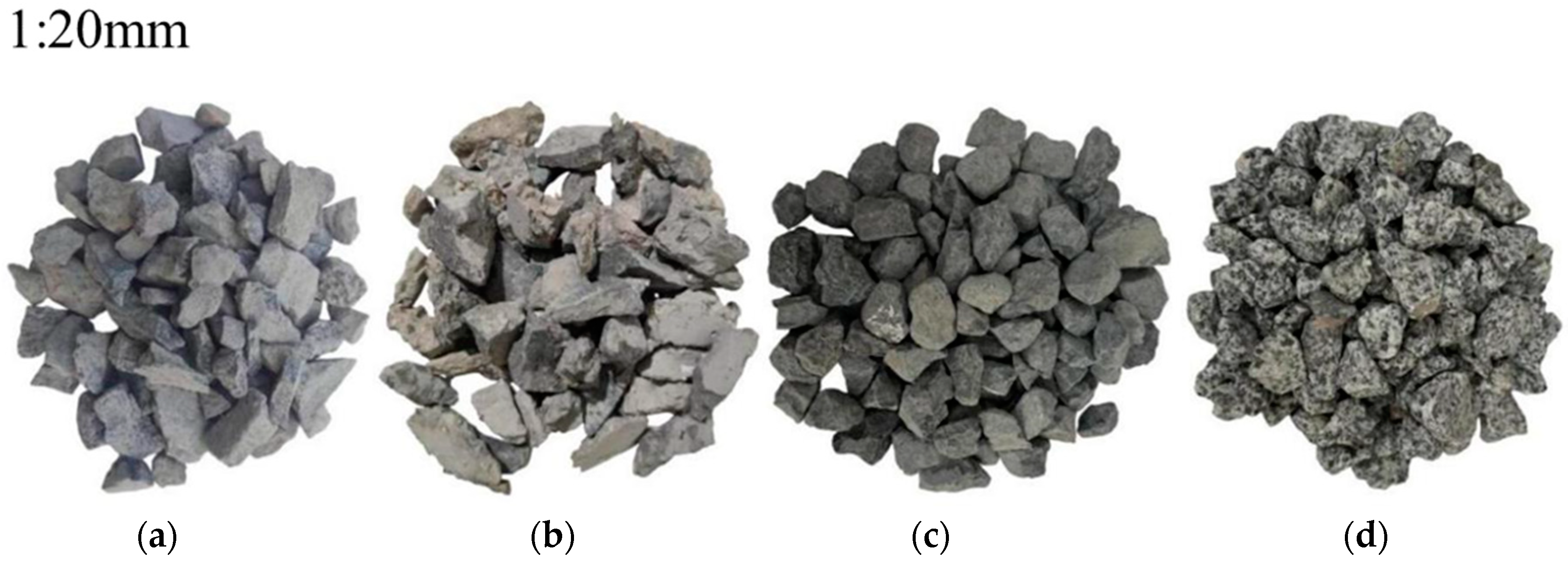
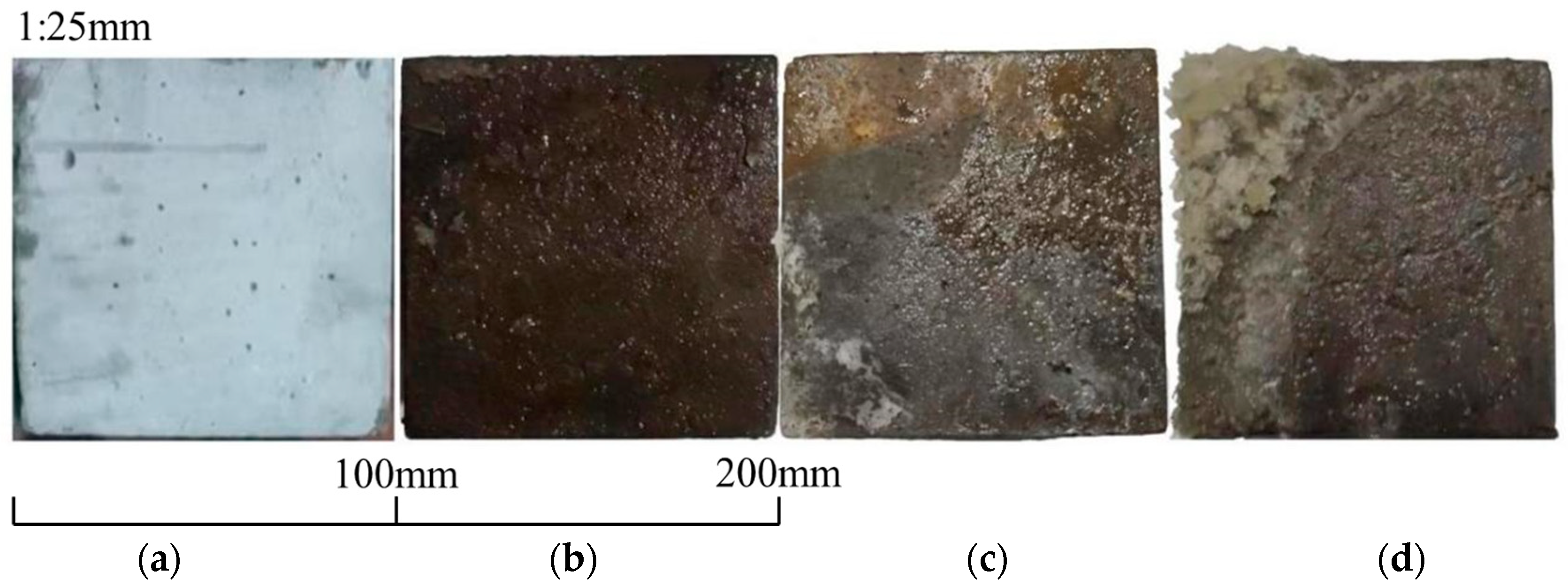
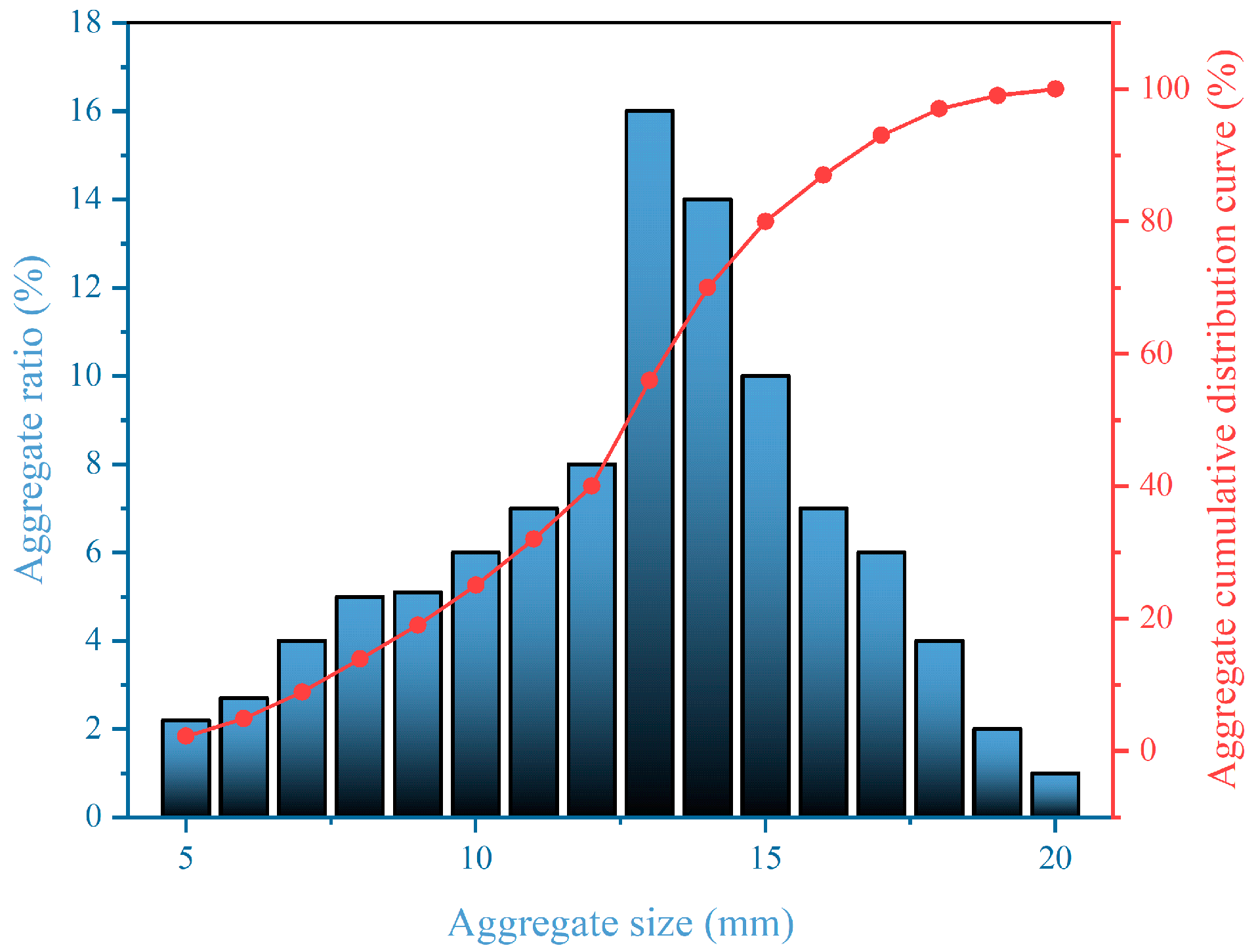


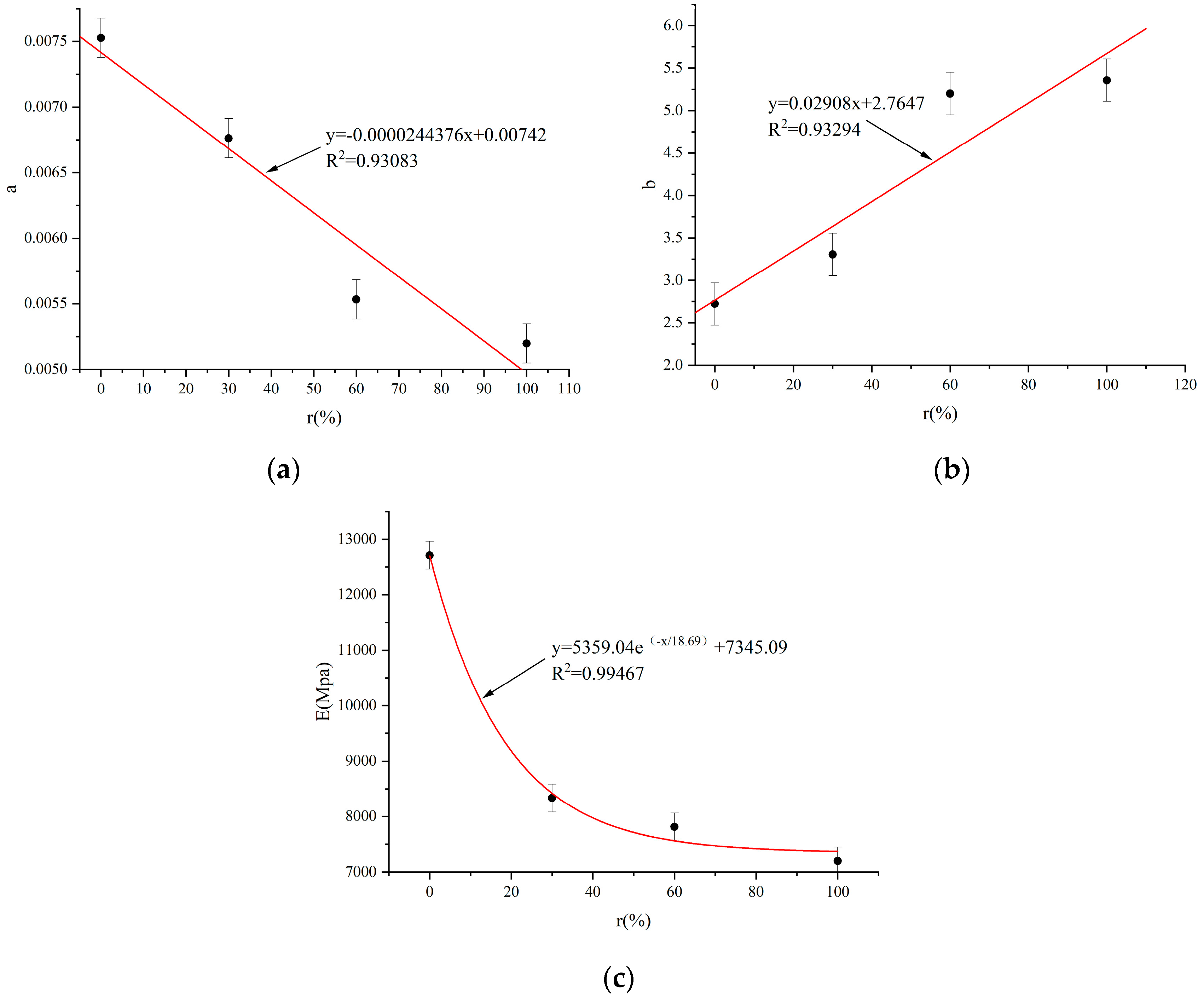

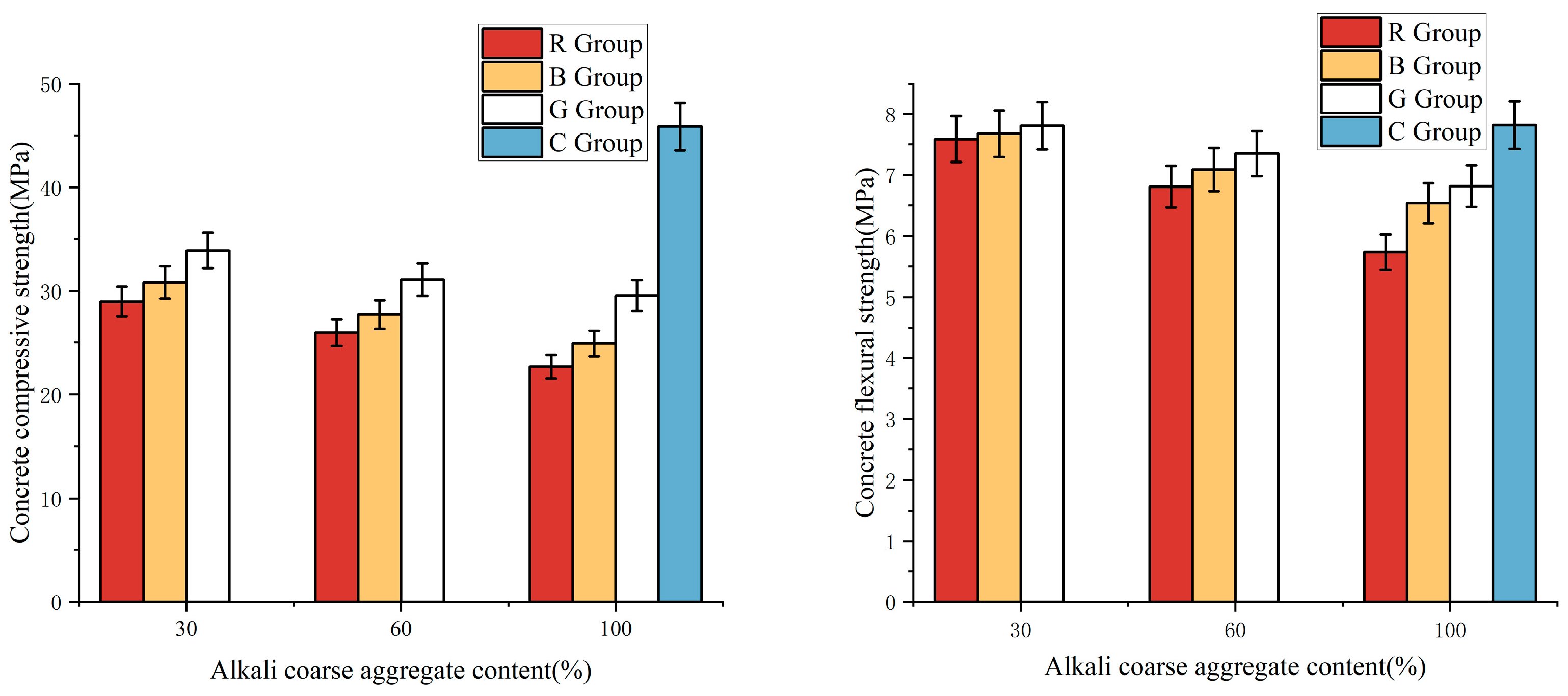
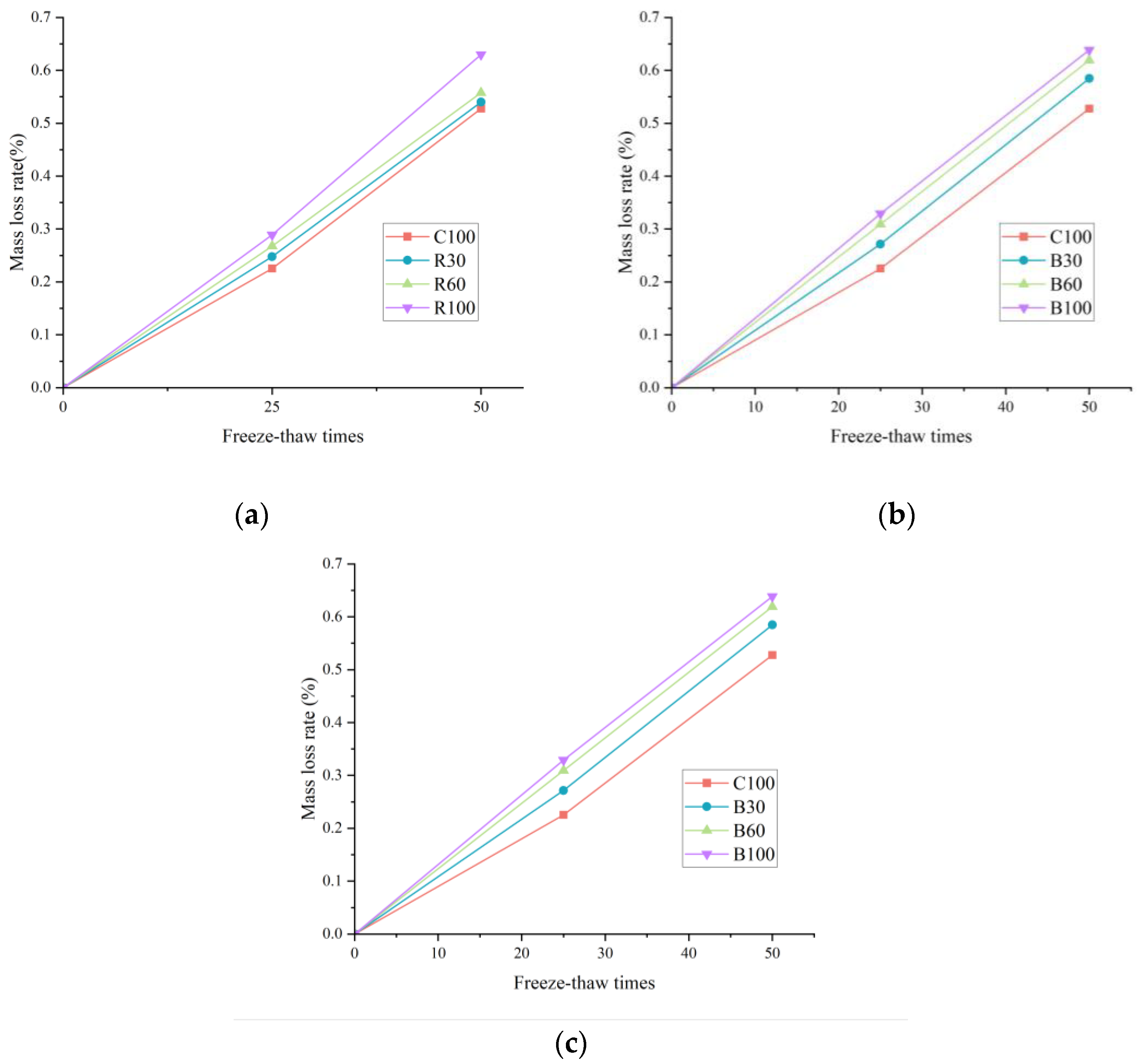

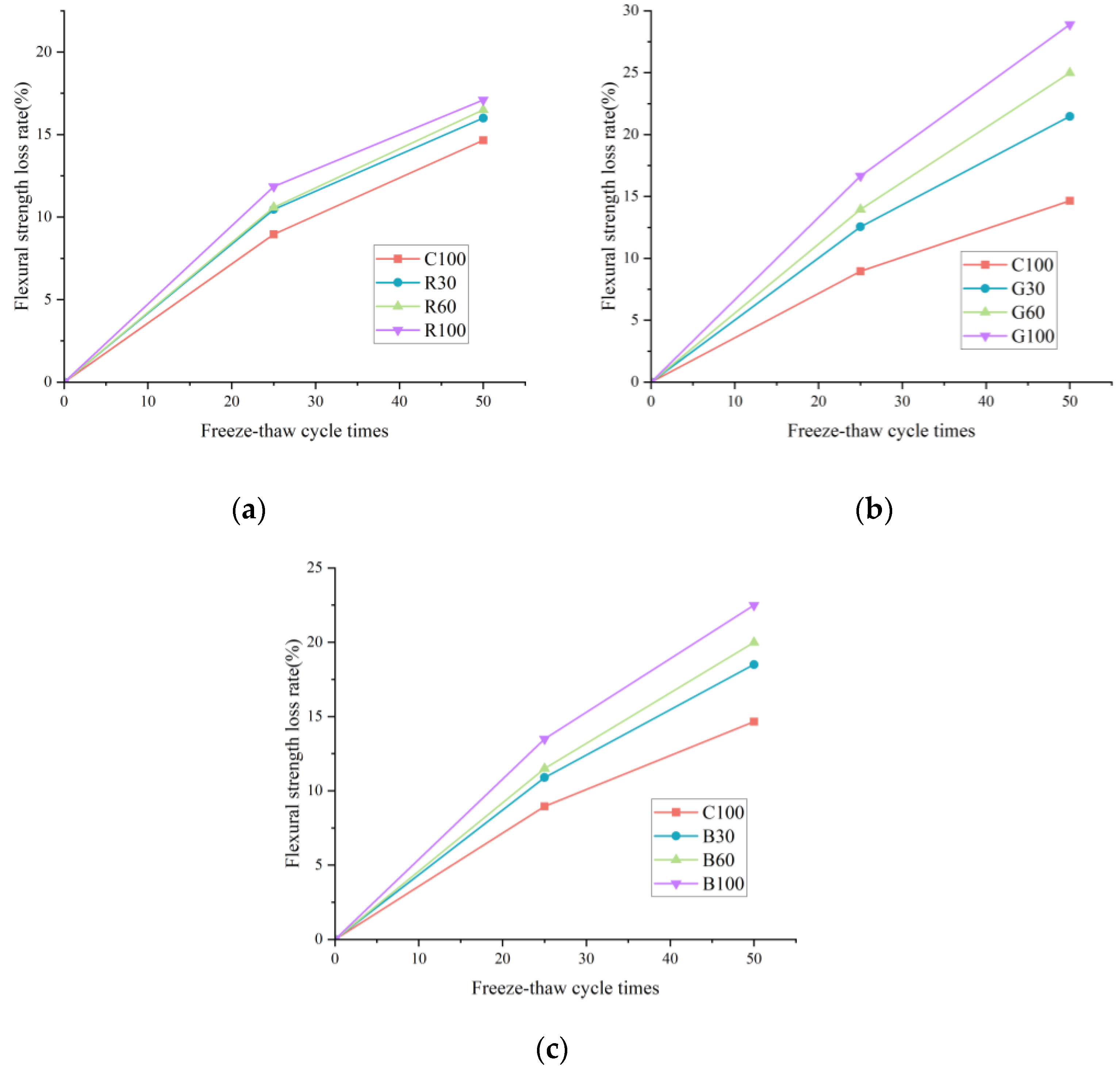
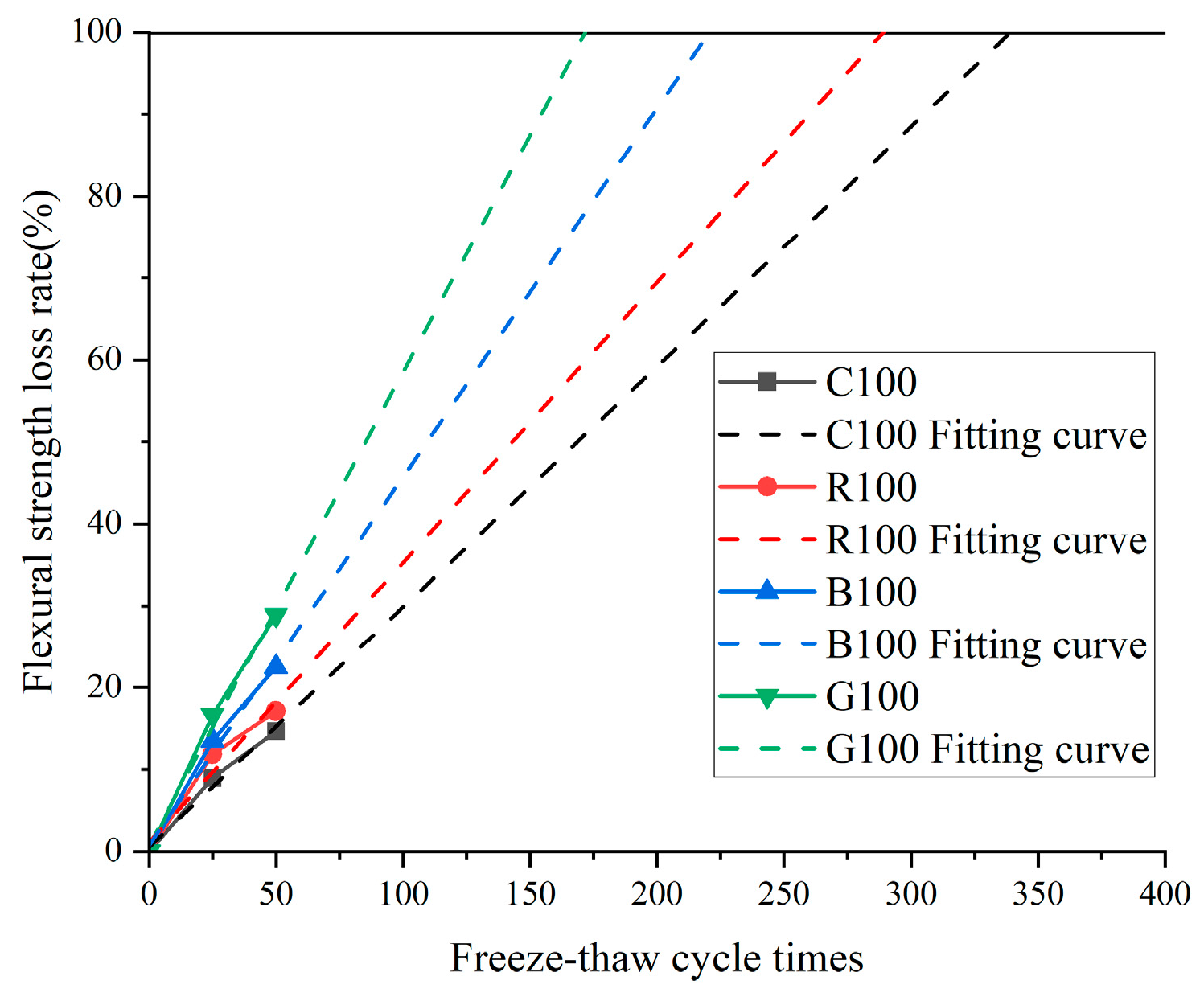
| Aggregate Type | Apparent Density (kg/m3) | Water Absorption (%) | Hardness (Mohs) | Size (mm) |
|---|---|---|---|---|
| Crushed stone | 2600 | 1.2 | 4.55 | 5–20 |
| Recycled concrete | 2500 | 6.0 | 4.54 | |
| Basalt | 2800 | 0.25 | 4.55 | |
| Granite | 2700 | 0.35 | 4.55 |
| Aggregate Type | Composition | Granulometry |
|---|---|---|
| Crush stone | SiO2 (60–80%), CaCO3 (5–15%), Fe2O3 (1–5%) | The ratio of 5–10 mm coarse aggregate and 10–20 mm coarse aggregate is 3:7 |
| Recycled concrete | Cement, Recycled aggregate | |
| Basalt | SiO2 (45–55%), Feldspar (20–30%), Mica (5–10%) | |
| Granite | SiO2 (70–80%), FeO (1–5%), MgO (1–4%) |
| Group | Water | Cement | Sand | Fiber | Crushed Stone | Recycled Concrete | Basalt | Granite |
|---|---|---|---|---|---|---|---|---|
| C100 | 195 | 487 | 613 | 0.91 | 1188 | 0 | 0 | 0 |
| R30 | 195 | 487 | 613 | 0.91 | 831.6 | 356.4 | 0 | 0 |
| R60 | 195 | 487 | 613 | 0.91 | 475.2 | 712.8 | 0 | 0 |
| R100 | 195 | 487 | 613 | 0.91 | 0 | 1188 | 0 | 0 |
| B30 | 195 | 487 | 613 | 0.91 | 831.6 | 0 | 356.4 | 0 |
| B60 | 195 | 487 | 613 | 0.91 | 475.2 | 0 | 712.8 | 0 |
| B100 | 195 | 487 | 613 | 0.91 | 0 | 0 | 1188 | 0 |
| G30 | 195 | 487 | 613 | 0.91 | 831.6 | 0 | 0 | 356.4 |
| G60 | 195 | 487 | 613 | 0.91 | 475.2 | 0 | 0 | 712.8 |
| G100 | 195 | 487 | 613 | 0.91 | 0 | 0 | 0 | 1188 |
| Group | Peak Strain | Peak Stress (MPa) | Elasticity Modulus (MPa) | a | b |
|---|---|---|---|---|---|
| C100 | 0.0052 | 45.86 | 12712 | 0.0075 | 2.72 |
| R30 | 0.0047 | 29.00 | 8334 | 0.0068 | 3.30 |
| R60 | 0.0040 | 25.98 | 7813 | 0.0055 | 5.20 |
| R100 | 0.0038 | 22.70 | 7198 | 0.0052 | 5.36 |
| Group | Compressive Strength (MPa) | Flexural Strength (MPa) |
|---|---|---|
| C100 | 45.86 | 7.82 |
| R30 | 29.00 | 7.59 |
| R60 | 25.98 | 6.81 |
| R100 | 22.69 | 5.74 |
| B30 | 30.84 | 7.68 |
| B60 | 27.75 | 7.09 |
| B100 | 24.93 | 6.54 |
| G30 | 33.92 | 7.81 |
| G60 | 31.12 | 7.35 |
| G100 | 29.58 | 6.82 |
Disclaimer/Publisher’s Note: The statements, opinions and data contained in all publications are solely those of the individual author(s) and contributor(s) and not of MDPI and/or the editor(s). MDPI and/or the editor(s) disclaim responsibility for any injury to people or property resulting from any ideas, methods, instructions or products referred to in the content. |
© 2024 by the authors. Licensee MDPI, Basel, Switzerland. This article is an open access article distributed under the terms and conditions of the Creative Commons Attribution (CC BY) license (https://creativecommons.org/licenses/by/4.0/).
Share and Cite
Huang, Y.; Ji, Y.; Wang, J.; Wang, Z.; Yu, B.; Zhang, S. Experimental and Modeling Analysis of Polypropylene Fiber Reinforced Concrete Subjected to Alkali Attack and Freeze–Thaw Cycling Effect. Materials 2024, 17, 4529. https://doi.org/10.3390/ma17184529
Huang Y, Ji Y, Wang J, Wang Z, Yu B, Zhang S. Experimental and Modeling Analysis of Polypropylene Fiber Reinforced Concrete Subjected to Alkali Attack and Freeze–Thaw Cycling Effect. Materials. 2024; 17(18):4529. https://doi.org/10.3390/ma17184529
Chicago/Turabian StyleHuang, Yuxiang, Yongcheng Ji, Jingchen Wang, Zihao Wang, Bosong Yu, and Siyu Zhang. 2024. "Experimental and Modeling Analysis of Polypropylene Fiber Reinforced Concrete Subjected to Alkali Attack and Freeze–Thaw Cycling Effect" Materials 17, no. 18: 4529. https://doi.org/10.3390/ma17184529
APA StyleHuang, Y., Ji, Y., Wang, J., Wang, Z., Yu, B., & Zhang, S. (2024). Experimental and Modeling Analysis of Polypropylene Fiber Reinforced Concrete Subjected to Alkali Attack and Freeze–Thaw Cycling Effect. Materials, 17(18), 4529. https://doi.org/10.3390/ma17184529






